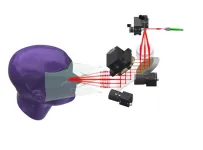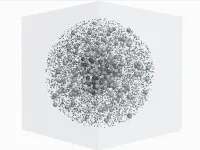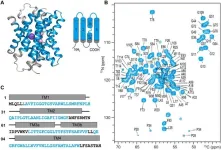(Press-News.org) *Note- this is an early release from the Annual Meeting of the European Association for the Study of Diabetes (EASD) meeting in Hamburg, October 2-6. Please credit the meeting if you use this story*
A new meta-analysis combining 22 studies, to be presented at this year’s Annual Meeting of the European Association for the Study of Diabetes (EASD) in Hamburg, Germany (2-6 October), shows that tirzepatide is superior to semaglutide for both control of blood sugar and in terms of amount of body weight lost by patients. The study is by Dr Thomas Karagiannis, Aristotle University of Thessaloniki, Thessaloniki, Greece, and colleagues.
Semaglutide is approved for treatment of type 2 diabetes and also obesity/weight loss management. Tirzepatide has been approved for treating type 2 diabetes and its manufacturers have submitted applications for its approval for obesity/weight loss management. There are few randomised controlled trials (RCTs) directly comparing subcutaneous tirzepatide with subcutaneous semaglutide*. In this new research, the authors combined the data from 22 available trials to perform a meta-analysis to compare tirzepatide with semaglutide in terms of their efficacy and safety in people with type 2 diabetes.
The authors searched Medline and the Cochrane Library for RCTs that assessed a maintenance dose of subcutaneous tirzepatide 5, 10, or 15 mg once-weekly or subcutaneous semaglutide 0.5, 1.0, or 2.0 mg once-weekly for at least 12 weeks. Comparators were any of the eligible doses of tirzepatide and semaglutide, placebo, and also other glucose-lowering drugs provided they were directly compared to tirzepatide and semaglutide in at least one trial. The meta-analysis then calculated any differences in effects on HbA1c (glycated haemoglobin, a measure of blood sugar control), body weight, and also the risk of adverse events.
The 22 RCTs included data from 18,472 patients, all with a diagnosis of type 2 diabetes. The authors found that tirzepatide 15 mg was the most efficacious in reducing HbA1c versus placebo (mean difference -2.00%), followed by tirzepatide 10 mg (-1.86%) and semaglutide 2.0 mg (-1.62%). Each of the three tirzepatide doses reduced HbA1c more than the respective low-, medium-, and high-dose of semaglutide. Versus placebo, tirzepatide was more efficacious in reducing body weight (-10.96 Kg, -8.75 Kg, and -6.16 Kg for tirzepatide 15, 10, and 5 mg respectively) than semaglutide (-5.24 Kg, -4.44 Kg, and -2.72 Kg for semaglutide 2.0, 1.0, and 0.5 mg respectively) (Figure in full abstract, link below). Regarding between-drug comparisons, both tirzepatide 10 and 15 mg were more efficacious in lowering body weight versus semaglutide 0.5, 1.0, and 2.0 mg, while tirzepatide 5 mg was more efficacious versus semaglutide 0.5 and 1.0 mg.
Although not in the linked abstract below, the authors have been able to provide results for change in body weight from the analyses comparing tirzepatide and semaglutide (rather than versus placebo as shown in the figure in the abstract). These numerical values will be presented in the oral presentation in the congress.
The actual differences in change in body weight (mean difference) for the following comparisons are (using data from the above paragraph and abstract figure):
Tirzepatide 15 mg versus semaglutide 2.0 mg = -5.72 Kg (ie, a mean of 5.72kg more weight lost in those taking tirzepatide 15 mg versus those taking semaglutide 2.0 mg)
Tirzepatide 10 mg versus semaglutide 2.0 mg = -3.52 Kg
Tirzepatide 5mg versus semaglutide 1.0 mg = -1.72 Kg
The authors explain: “In summary the three tirzepaide doses were more effective than the 3 respective semaglutide doses, with the difference between the two drugs being larger with the higher doses.”
As compared to placebo, all doses of tirzepatide and semaglutide increased risk for gastrointestinal adverse events, with tirzepatide 15 mg yielding the highest increased risk (3.6 times) for nausea, vomiting (4.4 times) and diarrhea (double the risk). Between-drug comparisons yielded non-statistically significant results, except for tirzepatide 15 mg versus semaglutide 1.0 mg (39% increased vomiting risk) and 0.5 mg (85% increased vomiting risk), and tirzepatide 15 mg versus semaglutide 0.5 mg (45% increased risk of nausea). There was no difference between tirzepatide, semaglutide and placebo regarding risk for serious adverse events.
The authors conclude: “In people with type 2 diabetes, tirzepatide 5, 10, and 15 mg were more efficacious in reducing HbA1c compared to semaglutide 0.5, 1.0, and 2.0 mg, respectively. Tirzepatide also was also more effective for weight loss than semaglutide, with a larger weight-loss effect at higher doses. High-dose tirzepatide (15 mg) was associated with increased risk for vomiting versus low- and medium-dose semaglutide.”
*Note to editors: Of the 22 trials included in the meta-analysis, there are 2 RCTs comparing tirzepatide with semaglutide (SURPASS-2 and another smaller trial). Both trials were included in the meta-analysis. The 20 remaining rials compared either semaglutide or tirzepatide with a common comparator (placebo or basal insulin or other GLP-RA-1 drugs) and were used to produce indirect comparisons between tirzepatide and semaglutide.
This press release is based on an early release of oral presentation 5 at the European Association for the Study of Diabetes (EASD) Annual Meeting in Hamburg, 2-6 October. All accepted abstracts have been extensively peer reviewed by the congress selection committee. There is no full paper at this stage, but the authors are happy to answer your questions. The research has not been submitted to a medical journal for publication. As it is an oral presentation there is no poster available.
END
Tirzepatide more effective in blood sugar control and body weight loss than semaglutide, shows meta-analysis of 22 studies
2023-09-23
ELSE PRESS RELEASES FROM THIS DATE:
NIH awards researchers $1.2M to develop robotic eye examination system
2023-09-22
A collaboration between researchers at the University of Illinois Urbana-Champaign and Duke University has developed a robotic eye examination system, and the National Institutes of Health has awarded the researchers $1.2 million to expand and refine the system.
The researchers have developed a robotic system that automatically positions examination sensors to scan human eyes. It currently uses an optical scan technique which can operate from a reasonably safe distance from the eye, and now the researchers are working to add more features that will help it perform most steps of a standard eye exam. These features will require ...
Nanofluidic device generates power with saltwater
2023-09-22
There is a largely untapped energy source along the world’s coastlines: the difference in salinity between seawater and freshwater. A new nanodevice can harness this difference to generate power.
A team of researchers at the University of Illinois Urbana-Champaign has reported a design for a nanofluidic device capable of converting ionic flow into usable electric power in the journal Nano Energy. The team believes that their device could be used to extract power from the natural ionic flows at seawater-freshwater boundaries.
“While our design is still a concept at this stage, it is quite versatile and already ...
New program helps health professionals and community members determine health risks and create medical interventions for people experiencing homelessness
2023-09-22
New Program Helps Health Professionals and Community Members Determine Health Risks and Create Medical Interventions for People Experiencing Homelessness
A consortium of population health professionals, physicians, frontline staff, and community partners in Toronto established the Community Assessment and Risk Evaluation (CARE) program, a rapid risk assessment and clinical population medicine intervention to respond to challenges faced by people experiencing homelessness (PEH). The intervention also helped characterize health needs and mitigate risks among this population. ...
ISSCR Kicks off São Paulo International Symposium today in Ribeirão Preto, Brazil
2023-09-22
The unique symposium, taking place 22-24 September 2023, is designed to highlight progress in the continuum of stem cell science from early development into clinical applications. Scientists from Latin America and across the globe are convening to share their latest stem cell research in areas such as pluripotency and early development and its adult counterpart, tissue stem cells and regeneration. Advances in understanding cellular plasticity through reprogramming and directed differentiation will be showcased as will the emerging field of tissue self-organization dynamics and innovative new technologies and tools that are driving the field forward. The program will be capped ...
Texas A&M researchers show endangered parrot species is thriving in urban areas
2023-09-22
A Texas A&M-led research team has discovered that a population of endangered red-crowned parrots is thriving in urban areas of South Texas. The parrots are a unique case, considering that many animal species are affected negatively by the expansion of human urban areas, which can lead to deforestation and pollution of natural habitats.
These mostly green parrots, which have a cluster of bright red feathers on their heads, are also an unusual example of a species that has adapted well in the face of poaching and the pet trade ...
Kinase-targeted therapy in subsets of colorectal cancer
2023-09-22
“We have summarized some of our findings regarding the response of various subsets of CRC to kinase inhibitors [...].”
BUFFALO, NY- September 22, 2023 – A new editorial paper was published in Oncoscience (Volume 10) on June 27, 2023, entitled, “Kinase-targeted therapy in subsets of colorectal cancer.”
In this new editorial, researchers Patricia M. Gomez Barila and Jan Paul Medema from the University of Amsterdam and Amsterdam University Medical Centers discuss colorectal cancer (CRC) — one of the most commonly diagnosed cancers and the second leading cause of cancer-related deaths worldwide. Early diagnosis and adequate treatment are crucial ...
Sylvester Research: Socioeconomic status linked with outcomes and survival in patients treated for non-small cell lung cancer
2023-09-22
MIAMI, FLORIDA (Sept. 22, 2023) – Researchers at Sylvester Comprehensive Cancer Center at the University of Miami Miller School of Medicine found an association between “social determinants of health” and outcomes and survival in patients undergoing surgery and treatment for non-small cell lung cancer.
The findings are based on a statistical scoring system the researchers developed that consolidates and analyzes several measures of socioeconomic status and related factors.
“We believe our social determinants of health scoring system is the first to provide a composite perspective on many of the ...
Scientists reveal marvellous x-ray mask absorber in the active galaxy NGC 6814
2023-09-22
A research team led by Prof. WANG Junxian from the University of Science and Technology of China (USTC) of the Chinese Academy of Sciences (CAS) revealed a clumped, multi-component eclipsing absorber in a study of X-ray occultation events in the active galaxy NGC 6814. The results were published in Monthly Notices of the Royal Astronomical Society on Aug. 23.
Active galactic nuclei have strong X-ray emission originating in a compact region near the supermassive black hole, the so-called corona region. When an absorbing ...
Tiny bubbles could reveal immune cell secrets and improve treatments
2023-09-22
UNIVERSITY PARK, Pa. — Macrophages are little cells vital to the immune system and could possibly inform cell-based therapies for a variety of medical conditions. However, realizing the full potential of macrophage therapies relies on being able to see what these cellular allies are doing inside our bodies, and a team of Penn State researchers may have developed a way to watch them do their thing.
In a study published in the journal Small, the Penn State researchers report a novel ultrasound imaging technique to view macrophages continuously in mammal tissue, with potential for human ...
Solid-state NMR unveils fluoride ion channel permeation mechanism
2023-09-22
On August 23, 2023, a research team led by SHI Chaowei from the University of Science and Technology of China (USTC) of the Chinese Academy of Sciences (CAS) published a paper titled "Fluoride permeation mechanism of the Fluc channel in liposomes revealed by solid-state NMR" in Science Advances. The team adopted the fluoride ion channel protein Fluc-Ec1 combined with deuterium substitution and 19F labeling methods, paving a new path for membrane protein nuclear magnetic resonance (NMR) research.
NMR not only provides insights into molecular structures ...







